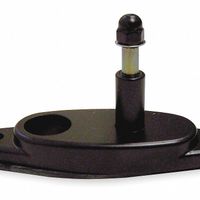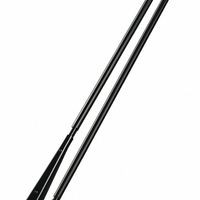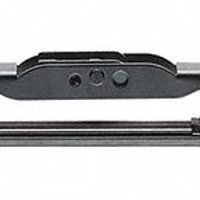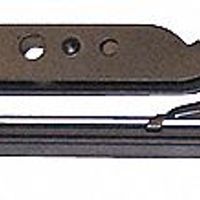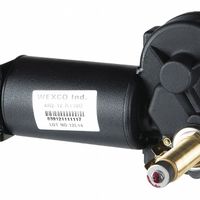Call +(254) 703 030 000 / 751 483 999 / 721 704 777
- Home
- Fleet Vehicle Maintenance
- Vehicle Windshield Maintenance
- Windshield Wiper Blades Parts
Windshield Wiper Blades & Parts
Windshield wiper blades work through rain, snow, sleet, and other debris that can dangerously obstruct views while driving. Blades should be replaced every six to 12 months depending on daily use. The wiper motor keeps blades moving across the windshield. Motors can burn out or short-circuit if blad .....Read More
Frequently Asked Questions
How often should windshield wiper blades be replaced?
Windshield wiper blades should generally be replaced every six to twelve months. However, the exact frequency can vary based on several factors, including climate, usage, and the quality of the wiper blades. In areas with harsh weather conditions, such as extreme heat, cold, or heavy rainfall, wiper blades may need to be replaced more frequently. Regular use, especially in areas with frequent rain or snow, can also lead to faster wear and tear.
Signs that indicate the need for replacement include streaking, skipping, or squeaking during operation, as well as visible cracks or tears in the rubber. It's important to regularly inspect the wiper blades for any signs of damage or deterioration. Maintaining clean windshields and wiper blades can also extend their lifespan, as dirt and debris can cause additional wear.
Ultimately, while the general recommendation is every six to twelve months, it's crucial to monitor the condition of the wiper blades and replace them as needed to ensure optimal visibility and safety while driving.
What are the signs that windshield wiper blades need replacing?
1. **Streaking or Smearing**: If the wipers leave streaks or smears on the windshield, it indicates that the rubber has worn out or is damaged.
2. **Chattering or Skipping**: When the wipers make a chattering noise or skip across the windshield, it suggests that the blades are not making proper contact with the glass.
3. **Squeaking Sounds**: Persistent squeaking noises during operation can be a sign that the rubber is hardening or the blades are misaligned.
4. **Cracks or Splits**: Visible cracks, splits, or missing pieces in the rubber edge of the wiper blades indicate they are deteriorating and need replacement.
5. **Bent Frame**: A bent or damaged wiper frame can prevent the blade from making full contact with the windshield, leading to ineffective wiping.
6. **Reduced Visibility**: If your visibility is compromised during rain or snow due to poor wiping performance, it’s time to replace the blades.
7. **Rubber Detachment**: If the rubber is separating from the wiper arm or appears loose, the blades are no longer effective.
8. **Age**: Wiper blades generally need replacement every 6 to 12 months. If it’s been longer, consider replacing them even if they seem to be functioning adequately.
9. **Corrosion**: Rust or corrosion on the metal parts of the wiper blades can affect their performance and is a sign they need replacing.
10. **Inconsistent Contact**: If parts of the windshield remain unwiped or the wipers only clear certain areas, the blades may be worn or misaligned.
How do I choose the right windshield wiper blades for my car?
To choose the right windshield wiper blades for your car, follow these steps:
1. **Consult the Owner’s Manual**: Check your vehicle’s manual for the recommended wiper blade size and type. This ensures compatibility with your car’s specifications.
2. **Measure the Blades**: If the manual is unavailable, measure the existing wiper blades. Use a tape measure to determine the length of each blade, as front and rear blades may differ.
3. **Consider the Climate**: Select blades suited to your local weather conditions. For instance, winter blades are designed to handle snow and ice, while all-season blades are versatile for various climates.
4. **Choose the Type**: Decide between conventional, beam, or hybrid blades. Conventional blades are cost-effective and suitable for most vehicles. Beam blades offer better performance in harsh weather due to their aerodynamic design. Hybrid blades combine features of both for enhanced durability and performance.
5. **Check Compatibility**: Ensure the blades are compatible with your car’s wiper arm type, such as hook, pin, or bayonet. Most packaging will indicate compatibility.
6. **Quality and Brand**: Opt for reputable brands known for durability and performance. While they may cost more, they often provide better longevity and effectiveness.
7. **Installation Ease**: Consider blades that are easy to install, especially if you plan to replace them yourself. Some brands offer quick-connect systems for hassle-free installation.
8. **Budget**: Set a budget but prioritize quality over cost. Cheaper blades may wear out faster, leading to more frequent replacements.
9. **Read Reviews**: Look for customer reviews and ratings online to gauge performance and reliability.
10. **Purchase Location**: Buy from trusted auto parts stores or online retailers to ensure authenticity and quality.
By following these steps, you can select the right windshield wiper blades that ensure clear visibility and safe driving.
Can I replace windshield wiper blades myself?
Yes, you can replace windshield wiper blades yourself. It is a straightforward process that typically requires no tools and can be completed in a few minutes. First, determine the correct size and type of wiper blades for your vehicle by consulting your car's manual or using an online tool from an auto parts retailer. Once you have the correct blades, lift the wiper arm away from the windshield until it locks in a raised position. Locate the release mechanism on the wiper blade; this is usually a small tab or button. Press or pull the release mechanism to detach the old blade from the wiper arm. Align the new blade with the wiper arm, ensuring it is oriented correctly, and slide it into place until you hear a click, indicating it is securely attached. Gently lower the wiper arm back onto the windshield. Repeat the process for the other wiper blade. Test the new blades by turning on your wipers to ensure they are functioning correctly.
How do I maintain windshield wiper blades for longer life?
1. **Regular Cleaning**: Clean the wiper blades and windshield regularly with a soft cloth and a mild detergent or a mixture of water and vinegar. This removes dirt, grime, and debris that can cause wear.
2. **Check for Damage**: Inspect the blades for cracks, tears, or any signs of damage. Replace them if they are worn out to prevent scratching the windshield.
3. **Avoid Sun Exposure**: Park your car in the shade or use a windshield cover to protect the wiper blades from UV rays, which can cause the rubber to deteriorate.
4. **Lift Blades in Winter**: In cold weather, lift the wiper blades off the windshield when parked to prevent them from freezing to the glass.
5. **Use Proper Fluid**: Use a good quality windshield washer fluid that can help in cleaning and maintaining the blades. Avoid using plain water, especially in freezing temperatures.
6. **Avoid Dry Wiping**: Never use the wipers on a dry windshield. Always ensure the glass is wet to reduce friction and wear on the blades.
7. **Seasonal Replacement**: Consider replacing the wiper blades every six months or at the start of a new season to ensure optimal performance.
8. **Proper Storage**: If you live in an area with extreme weather, consider removing the wiper blades when not in use for extended periods.
9. **Check Alignment**: Ensure the wiper arms are properly aligned and not bent, as misalignment can cause uneven pressure and wear on the blades.
10. **Use Silicone Blades**: Consider using silicone wiper blades, which tend to last longer than traditional rubber blades due to their resistance to environmental factors.
What causes windshield wiper motors to fail?
Windshield wiper motors can fail due to several reasons, including:
1. **Electrical Issues**: Faulty wiring, blown fuses, or a malfunctioning relay can disrupt the electrical supply to the motor, causing it to fail.
2. **Mechanical Wear and Tear**: Over time, the internal components of the motor, such as gears and bearings, can wear out due to continuous use, leading to failure.
3. **Corrosion**: Exposure to moisture and road salt can cause corrosion in the motor or its connections, impairing its function.
4. **Overloading**: Trying to operate the wipers when they are obstructed by ice, snow, or debris can overload the motor, causing it to burn out.
5. **Poor Lubrication**: Lack of proper lubrication can increase friction within the motor, leading to overheating and eventual failure.
6. **Faulty Linkage**: The linkage connecting the motor to the wiper arms can become loose or broken, preventing the motor from moving the wipers effectively.
7. **Motor Brushes**: The brushes inside the motor can wear down over time, reducing contact with the commutator and causing the motor to fail.
8. **Voltage Spikes**: Sudden increases in voltage can damage the motor's electrical components, leading to failure.
9. **Manufacturing Defects**: Occasionally, defects in the motor from the manufacturing process can lead to premature failure.
10. **Environmental Factors**: Extreme temperatures can affect the motor's performance, with cold weather causing components to become brittle and hot weather leading to overheating.
Regular maintenance, such as checking electrical connections, ensuring proper lubrication, and avoiding operating the wipers under heavy load, can help prevent motor failure.
How do I troubleshoot windshield wiper motor problems?
1. **Check the Fuse**: Locate the fuse box and find the fuse for the windshield wipers. If it's blown, replace it with one of the same amperage.
2. **Inspect the Wiper Blades and Arms**: Ensure the wiper blades and arms are not obstructed or damaged. Clear any debris and ensure they move freely.
3. **Test the Wiper Switch**: Turn the wiper switch on and off. If the wipers don't respond, the switch might be faulty. Use a multimeter to check for continuity.
4. **Listen for Motor Noise**: Turn on the wipers and listen for motor noise. If the motor runs but the wipers don't move, the linkage might be disconnected or broken.
5. **Check the Wiring and Connections**: Inspect the wiring and connectors leading to the motor for corrosion, damage, or loose connections. Clean and secure them as needed.
6. **Test the Motor**: Use a multimeter to check for power at the motor when the wipers are turned on. If there's power but the motor doesn't run, the motor may be faulty.
7. **Inspect the Linkage**: If the motor runs but the wipers don't move, check the linkage connecting the motor to the wiper arms. Look for broken or disconnected parts.
8. **Examine the Motor Gear**: If the motor runs but the wipers don't move, the gear inside the motor might be stripped. Disassemble the motor to inspect and replace the gear if necessary.
9. **Replace the Motor**: If all else fails and the motor is not functioning, consider replacing it with a new one. Ensure compatibility with your vehicle model.
10. **Consult a Professional**: If troubleshooting doesn't resolve the issue, consult a professional mechanic for further diagnosis and repair.
